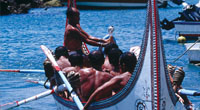|
09:00 - 11:15 |
Plenary & Opening Ceremony |
|
C. K. Lee
Professor, National Taiwan University
Influence of Ocean Resources and Technology in the Emerging Energy and Carbon Reduction Architecture of Taiwan’s National Energy Program Phase II
Taiwan has a unique geographic and geological environment. The country’s energy policies follow three major objectives: (1) Security - to ensure stability of energy supply; (2) Efficiency - to strengthen energy utilization management; (3) Cleanliness - to move towards low-carbon energy and utilize low-carbon technology whenever possible. To achieve these three objectives, six main focus centers with specific emphasis have been organized to link R&D efforts of academia, research institutes, and industries together on a common platform. These six focus centers are categorized into two distinct lines. The first line, Virtual Power Plant & Energy Management Architecture consists of three Focus Centers; (1) Energy Conservation, (2) Alternative Energy and (3) Smart Grid. This Virtual Power Plant & Energy Management Architecture places a priority on applications and implementation. The second line which deals with Emerging Energy and Carbon Reduction Architecture incorporates the three Focus Centers of (4) Offshore Wind Power & Marine Energy, (5) Geothermal Energy & Gas Hydrate and (6) Carbon Reduction & Clean Coal. This talk will provide a brief overview of the planning process and the on-going progress. Influences of ocean resources such as ocean energy, offshore wind farms, and offshore gas hydrate technology will also be detailed in this Phase II of Taiwan’s National Energy Program.
Biography
Chih-Kung Lee received his Ph.D. degree from Cornell University. In 1987, he joined IBM’s Almaden Research Center in San Jose, California as a Research Staff Member where his R&D work was primarily concentrated in the interdisciplinary areas related to magnetic disk drives, optoelectronic systems, metrology systems, and piezoelectric systems.
He joined the faculty of National Taiwan University’s Institute of Applied Mechanics in 1994. His research work on distributed piezoelectric sensors and actuators has made him a well- recognized expert in the areas of flexible structure control, shock sensing, and sensor development. He co-founded the National Taiwan University Nano-Bio-MEMS research group. The Group’s perspective of emphasizing social responsibility as a cornerstone of a world class research team truly sets the team apart from other research teams. He is concurrently a Professor in the Department of Engineering Science & Ocean Engineering at NTU. He is an IoP Fellow and ASME Fellow.
From August 2004 to July 2007, he was on loan to Taiwan’s National Science Council where he served as Director-General of Engineering & Applied Sciences. From October 2007 to July 2010, he held an adjunct appointment as Executive Vice-President of the Industrial Technology Research Institute (ITRI). From August 2010 to September 2012, he held an adjunct appointment as President of the Institute for Information Industry (III). Since April 2013, he has been appointed by Taiwan’s National Science Council and Ministry of Economic Affairs to serve as CEO and co-PI for Phase II of Taiwan’s National Energy Program. This important national program will be the main technology vehicle to set the direction of Taiwan’s energy program. In addition it is responsible for supervising and keeping track of all energy related research programs in Taiwan from 2014 to 2018.
|
|
|
Tamaki Ura
Professor, The University of Tokyo
New Program for Enhancement of Development of Marine Mineral Resources
Japan is about to start a new five-year program so called "Zipangu in the Ocean Program", one of Strategic Innovation Programs (SIP) of Council for Science and Technology Polity, to enhance the exploration of marine mineral resources, i.e. hydro-thermal deposit, cobalt rich manganese crust, and rare-earth elements in deep-sea mud. The program consists of three sub-projects which are intended for 1) the understandings of geological feature of mineral deposits, 2) the development of new technologies for their survey, and 3) the development of necessary technologies for survey of ecosystem in the deep sea. The program led by Tetsuro Urabe, Professor emeritus at Tokyo University will be carried out by JAMSTEC (Japan Agency for Marine-earth Science and TEChnology), AIST (national institute of Advanced Industrial Science and Technology), NMRI (National Maritime Research Institute), PARI(Port and Airport Research Institute), NICT (National institute of Information and Communications Technology), NIES (National Institute for Environmental Studies), and industries. In the keynote talk, I will introduce the master plan of the project and what has been done for this program.
Biography
Tamaki Ura is the Professor emeritus of the University of Tokyo, Director, Project Professor of Center for Socio-Robotic Synthesis, Kyushu Institute of Technology, and Director of Underwater Technology Center of National Maritime Research Institute, since his retirement of the University of Tokyo in 2013.
He is one of the Top-leaders of development of Autonomous Underwater Vehicle in the world.
He has developed not only Autonomous Underwater Vehicles (AUVs) but also various related application technologies including navigation methods, a new sensing method using a chemical sensor, precise seafloor mapping methods, a precise seabed positioning system with a resolution of a few centimeters, a new sensing system of the thickness of cobalt-rich crust, etc. Finally, he exemplified using these technologies that AUVs are practicable and valuable tools for deep-sea exploration.
Dedicating himself to international societies’ activities, establishing IEEE/OES Japan Chapter, he served it as its first chair from 1995 to 2000. He organized international symposium on underwater technology: UT'98, UT2000, UT'02, UT’07, UT’11, UT’13 at Tokyo and UT'04 at Taipei, UT’09 at Wuxi with co-sponsor IEEE/OES and realized the international symposium on OCEANS/Techno-Ocean 2004, Kobe in November 2004, which is the first OCEANS conference held in Asia.
Not only for the academic fields but also for the public, he has been contributing to the Ocean related themes. He works as a cabinet consultant for ocean policy since 2007. He was a Commissioned Judge of the High Marine Accidents Inquiry Agency from 1984 to 2008, and he was the chairman of the Ocean Technology Committee of the Society of Naval Architects of Japan from 1998 to 2000 as well.
Based on these activities, he has received awards:
2013: Technical Achievement award (Robotics and Mechatronics Division) from the Japan Society of
Mechanical Engineers
2012: AUV “TUNA SAND” was awarded the 5th Robot Award from METI (Japan)
2010: IEEE Oceanic Engineering Society Distinguished Technical Achievement Award (USA)
2007: Nominated as IEEE Fellow, for contributions to autonomous underwater vehicle technologies. (USA)
2006: Distinguished Service Award from IEEE Japan Chapter (Japan)
2000: Award from Agency for science and technology (Japan)
1999: Award from the Japan Society of Mechanical Engineers (Japan)
1998: Award from High Automation Technology Association (Japan)
1995 and 1997: Awards on Invention from the Society of Naval Architects of Japan (Japan)
1982: Houkou Award on the significant contributions to safety of moored ship (Japan)
1979: Award from the Society of Naval Architects of Japan (Japan)
|
|
|
Feng Liu
Director General of China National Deep Sea Center (NDSC)
Ten Years Way to the Hadal Depth -- A Retrospect of JIAOLONG’s Development
The speech will concentrate on the following 4 aspects: (1) Hardships of project defining, research and development when long-lasting hot debates for decision making and great efforts made in JIAOLONG’s growth were experienced; (2) Four years sea trials from shallow to the hadal depth that finally lead JIAOLONG’s successful dive to a depth of 7062m in Mariana Trench; (3) Maiden scientific dives in three legs which were carried out in South China Sea, in CCF Zone in Northeast Pacific and at seamounts in Northwest Pacific, respectively in 2013; (4) Call for collaboration based on the thinking that no single scientist, nor an institution could solely takes the whole challenge and bear the whole burden in probe the deep ocean, therefore, sharing experiences in operation, manufacture, regulation and training of all related institutions and professionals around the world would be a solution.
Biography
LIU Feng is now the Director-General of China National Deep Sea Center (NDSC), a newly established platform for the management and operation of national deep sea facilities, which is located in Qingdao, a coastal city in northeast China.
Mr. Liu received a bachelor of science degree in Mining Machinery from the Beijing Institute of Iron and Steel Technology (BIST) in 1983, a master’s degree from the Beijing University of Science and Technology (BUST) in 1986, and an MBA in 2002 from the Executive MBA Program jointly administered by the State University of New York at Buffalo, and China Renmin University. He was a lecturer at BUST from 1986 to 1991, and joined China Ocean Mineral Recourses R&D Association iCOMRAj when the organization was first established in 1991.
Since his integration with COMRA, he has been closely involved in management of China’s deep sea technology developments. For the past ten years he has personally spearheaded JIAOLONG project and was the Chief Commander for the four years sea trials of the submersible which successfully dived to a depth of 7062m in Mariana Trench in 2012. He also lead JIAOLONG’s maiden scientific dives in South China Sea, CCF Zone in Northeast Pacific and at seamounts in Northwest Pacific, respectively in 2013. Mr. Liu was appointed as Director-General of NDSC in 2012.
Mr. Liu has also closely involved in international seabed issues and participated in the International Seabed Authority’s Annual Session many times.
|
|
|
Ken Takagi
Professor, The University of Tokyo
A Floating Type Ocean Current Turbine System
Recently, R&D of marine renewable energy becomes very popular all over the world. In Japan many feasibility studies have been started. Ocean current energy is one of promising power resource for Japan, since KUROSHIO, which pass through near the Japanese coast, is one of strongest ocean current in the world. If we use 10% of KUROSHIO’s energy, we can cover the 5% of electricity demand of Japan.
Cost of renewable energy device is one of very important issues to deploy it widely as a commercially available energy system. The weight of the device is very important to minimize the cost of it. Floating type marine current turbine is one of promising concepts, since the device is supported by the buoyancy and additional supporting structure is not necessary. Another good point of floating type is that the wave effect on the device is small since the float is submerged.
We formed a consortium to study on a floating type ocean current turbine system in 2011, and a 5 years-project has been started. The project is supported by New Energy and Industrial Technology Development Organization (NEDO). Our target is establishment of elemental technologies and actual sea test by 2015.
A conceptual design is performed, according to the assumption of current velocity. A turbine which is suitable for ocean current is developed and structural strength of it is investigated. A maintenance-free direct-drive permanent magnet generator and power conditioning system, which are contained in the pod is also developed. In order to obtain the fluid dynamic forces on the floating body and turbines, experiments in a towing tank are carried out. A measurement of turbine performance is also carried out. In this presentation I will show results obtained in the early stage of the project.
Biography
Ken Takagi received the B.Eng. degree, the M. Sc. and the Dr. of Engineering from Osaka University, Osaka Japan.
Ken is professor of the University of Tokyo, Department of Ocean Technology, Policy, and Environment. He served as an assistant professor and associate professor in Department of Naval Architecture and Ocean Engineering at Osaka University for 23 years, and he moved to the University of Tokyo in 2008. He is studying on the ocean renewable energy and underwater vehicles, and teaching the fluid dynamics and the ocean technology policy. He has published about sixty journal papers in the field of ocean engineering and naval architecture since 1985.
Ken is IEEE/OES Japan Chapter Chair since 2010, and Elected member of the AdCom 2013-2015. He served as General Chair of OCEANS MTS/IEEE Kobe-Techno-Ocean’08.
|
|
|
M.A. Atmanand
Director, The National Institute of Ocean Technology of India
Ocean Observations program of India
The Ocean observing system has a central role to deliver ocean services to the society. Recognizing the importance of ocean observations in the Indian Oceanin terms of understanding our ocean environment and utilize them for operational oceanography, Ministry of Earth Sciences, Govt. of India has mounted large number of platforms to acquire different ocean variables in and around Indian Seas. National Institute of Ocean Technology (NIOT), under the Ministry of Earth Sciences, is entrusted with setting up of in situ observations under Ocean Observation programme in India. This programme started in India in a big way from the late 1990s with the deployment of data buoys in the Bay of Bengal and Arabian Sea. Since then this programme has grown both operationally and technologically. Systematic efforts led to continuous data availability, modernization in data collection and reception facility and capability to cater to the need of scientific community.
Initially these moored buoys were imported. Currently, the buoy’s hull and on board processor and telemetry system are indigenized and it is functional at sea. However, the sensors, which are of International standard, continue to be imported. The need for sub surface observations was demanded by oceanographers and atmospheric scientists in the country to improve studies on air-sea interactions. This led to the setting up of an OMNI buoy network of 12 buoys in the Arabian Sea and Bay of Bengal. It has grown in telemetry from 14 parameters per transmission in 1997 to 104 parameters now. Most importantly reliability of performance of buoy system have improved due to persistent efforts, continued interaction with global players and capacity building exercises undertaken.
The devastating tsunami of 24th December, 2004 saw a new challenge of setting up of bottom pressure recorder for measurement of sea water level changes due to undersea seismic event and its transmission to the data centre at NIOT through satellite. Soon the surface buoy of this was indigenized.
With the setting up of many buoys, vandalism became a routine affair and design modifications were taken up at various levels - mechanical and electrical. The design improvements proved to be beneficial and the number of incidents of vandalism drastically reduced. Also faced with issues of Piracy in Arabian Sea, armed guards were introduced for the first time to undertake field scientific mission that showed commitment to the programme.
A state of the art data reception station was set up, which gives the on line information of the data from all the buoys, apart from its status, condition, location etc. The operations are fully automated and it gives appropriate warnings through text messages to the concerned in cases of emergency.
Argo floats which measure the ocean temperature and salinity was another requirement, which lead to the Indian Argo programme by deploying scores of Argo floats in the Indian seas. Drifters were being deployed in the Indian seas even before the 90s. However, they were imported with communication facility through foreign satellites. Drifters with communication using Indian satellites have been currently developed and they are undergoing sea trials.
This paper gives an overall view of the Ocean observation programme which has dramatically improved the weather prediction capability of the country. The recent accurate prediction of land fall point of Phailin cyclone, both in time and space is a fine example of the same.
Biography
Dr. M.A.Atmanand, currently the Director of National Institute of Ocean Technology and Project Director of Integrated Coastal and Marine Area Management has done pioneering work in the area of deep sea technologies in India. An Instrumentation and Control Engineer by profession, he took his undergraduate degree from University of Calicut, Master’s and doctorate degrees from Indian Institute of Technology, Madras.
He led a team of Engineers for the design and development of underwater crawler for deep sea operation. He and his team developed the in-situ soil tester which was tested at a depth of 5200 m in the Central Indian Ocean Basin. It was under his supervision that the design of Electrical, Instrumentation and Control system of the India’s first Remotely Operable Vehicle was done. This was later tested at a depth of 5289 m water depth. He has also guided various indigenization programmes for Ocean observation and under water systems.
Some of the areas he contributed are:
-
Technologies for the extraction of Poly Metallic Nodules from deep sea, to retain ‘pioneer investor’ status for India, granted by International Sea Bed Authority of United Nations
-
Development of Power and Control Systems for deep water Submersibles for depths up to 6000 meters.
-
Development of allied technologies for Underwater vehicles, which have become mainstay all such projects in India
-
Power Generation modules for wave Energy and Ocean Thermal Energy Conversion (OTEC)
-
Development of underwater Systems and components like motor, fibre optic connectors etc.
-
Establishment of electronic support facilities and tsunami early warning systems
-
CO2 sequestration in the ocean
Dr. M.A.Atmanand has published 62 papers including International Journals, International conferences, National Conference and others. He received National Geoscience award 2010 from Ministry of Mines, Government of India and the International Society for Offshore and Polar Engineers (ISOPE) Ocean Mining Symposium award in the year 2009. He has widely travelled in capacities like technology transfer, as part of delegations etc. to countries like Russia, USA, Germany, Portugal, Korea, Japan etc. He received United Nations fellowship in 1985 – 86.
He is member of many professional bodies, Senior member of IEEE and Founding Chairman of IEEE Oceanic Engineering Society of India and has served IEEE in various capacities.
|
|









